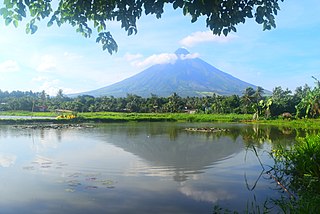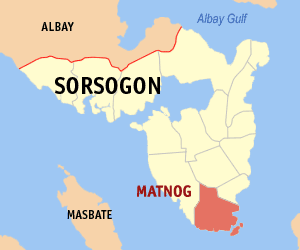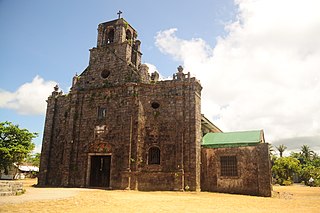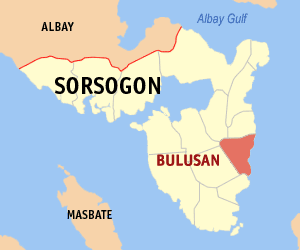
Sorsogon, is a province in the Philippines located in the Bicol Region. It is the southernmost province in Luzon and is subdivided into fourteen municipalities (towns) and one city. Its capital is Sorsogon City and borders the province of Albay to the north.

The Bicol Region, also known simply as Bicol and historically known as Ibalong prior to Spanish colonization, is a region of the Philippines, designated as Region V. Bicol comprises six provinces, four on the Bicol Peninsula mainland – Albay, Camarines Norte, Camarines Sur, and Sorsogon – and the offshore island provinces of Catanduanes and Masbate.

Casiguran, officially the Municipality of Casiguran, is a 4th class municipality in the province of Sorsogon, Philippines. According to the 2015 census, it has a population of 32,842 people.

Lucena, officially the City of Lucena, is a 1st class highly urbanized city in Calabarzon region. It is the capital city of the province of Quezon where it is geographically situated but, in terms of government and administration, the city is politically independent from the province. For statistical and geographical purposes, Lucena is grouped with the province of Quezon. According to the 2015 census, it has a population of 266,248 people.

Matnog, officially the Municipality of Matnog, is a 3rd class municipality in the province of Sorsogon, Philippines. According to the 2015 census, it has a population of 41,101 people.Its port is one of the busiest in the region, playing host to millions of people crossing the San Bernardino Strait to Northern Samar annually.

Daraga, officially the Municipality of Daraga, is a 1st class municipality in the province of Albay, Philippines. According to the 2015 census, it has a population of 126,595 people.

Manito, officially the Municipality of Manito, is a 4th class municipality in the province of Albay, Philippines. According to the 2015 census, it has a population of 24,707 people.

Barcelona, officially the Municipality of Barcelona ; Tagalog: Bayan ng Barcelona), is a 5th class municipality in the province of Sorsogon, Philippines. According to the 2015 census, it has a population of 20,990 people.

Bulan, officially the Municipality of Bulan, is a 1st class municipality in the province of Sorsogon, Philippines. According to the 2015 census, it has a population of 100,076 people.

Bulusan, officially the Municipality of Bulusan, ; Tagalog: Bayan ng Bulusan), is a 4th class municipality in the province of Sorsogon, Philippines. According to the 2015 census, it has a population of 22,884 people.

Castilla, officially the Municipality of Castilla, is a 3rd class municipality in the province of Sorsogon, Philippines. According to the 2015 census, it has a population of 57,827 people.

Donsol, officially the Municipality of Donsol, is a 3rd class municipality in the province of Sorsogon, Philippines. According to the 2015 census, it has a population of 49,711 people.

Gubat, officially the Municipality of Gubat, is a 2nd class municipality in the province of Sorsogon, Philippines. According to the 2015 census, it has a population of 59,534 people.

Juban, officially the Municipality of Juban, is a 4th class municipality in the province of Sorsogon, Philippines. According to the 2015 census, it has a population of 32,320 people.

Pilar, officially the Municipality of Pilar, is a 1st class municipality in the province of Sorsogon, Philippines. According to the 2015 census, it has a population of 74,564 people.Pilar's economy is mainly agricultural. Despite efforts on multiplicity, this town is still dependent on the monoculture of coconut.

Santa Magdalena, officially the Municipality of Santa Magdalena, is a 5th class municipality in the province of Sorsogon, Philippines. According to the 2015 census, it has a population of 16,848 people.

Monreal, officially the Municipality of Monreal, is a 4th class municipality in the province of Masbate, Philippines. According to the 2015 census, it has a population of 26,614 people.

San Jacinto, officially the Municipality of San Jacinto, is a 4th class municipality in the province of Masbate, Philippines. According to the 2015 census, it has a population of 30,372 people.

Calabanga, officially the Municipality of Calabanga, is a 1st class municipality in the province of Camarines Sur, Philippines. According to the 2015 census, it has a population of 83,033 people.
The legislative districts of Sorsogon are the representations of the province of Sorsogon in the various national legislatures of the Philippines. The province is currently represented in the lower house of the Congress of the Philippines through its first and second congressional districts.






















